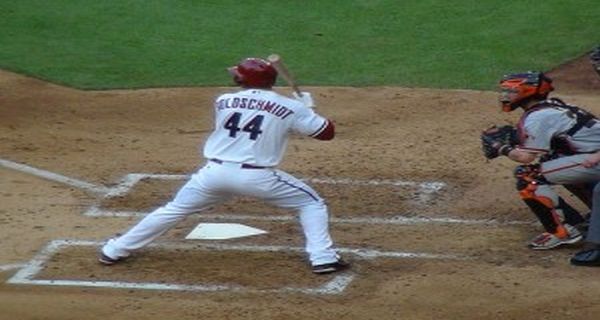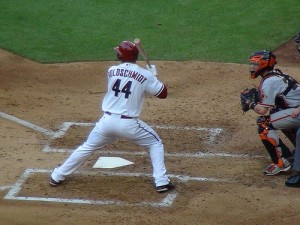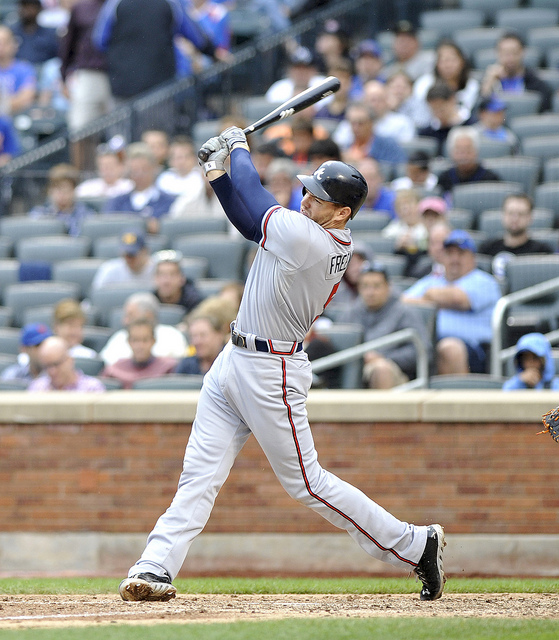Fantasy Baseball: Fueling the Hype Machine for Paul Goldschmidt


Paul Goldschmidt belongs in the same draft conversation as Albert Pujols, Joey Votto and Prince Fielder. Hell, in a vacuum, I’d take him ahead of Fielder without a moment’s hesitation.
Our own Albert Lang wrote a cautionary piece last week (which I encourage you to check out), warning about the dangers of the unbridled optimism driving Paul Goldschmidt up the ADP charts.
For me, we’re not quite optimistic enough yet; Goldschmidt’s mid-20s ADP is at least five spots too low.
My view is partly due to my undying love for Goldy’s skill set (we’ll get to that later), but just as much, it’s a casualty of my nagging doubt about the future of the first base position.
In real baseball terms, the league’s first basemen are in the beginnings of a much-needed physical retooling. Teams have smartly realized that the lumbering first sackers who dominated my youth aren’t worth the Mitchell Report paper their names were printed on. In fantasy, one-dimensional players don’t have much room for error. A power-only guy is great when he hits 50 home runs, but if that number dips to 35, he’s a wasted draft pick. We haven’t seen a high level of power-only production from first base over the last few seasons; no first baseman has cracked the 50 homer mark since Prince Fielder swatted exactly 50 bombs all the way back in 2007.
The league is becoming less McGwire, more Mientkiewicz.
The trend starts before players even enter the league. Teams are prioritizing all-around physical tools and positional flexibility in the amateur draft, which doesn’t bode well for players whose high school or college teams stuck them at first base because they couldn’t fit anywhere else.
The effect redoubles once these draftees enter their club’s minor league system. Teams are smart enough to know that a power-hitting outfielder or third baseman will generate more value for them than the same hitter at first base; anybody who can tighten past the first hole on his uniform belt is going to get a shot to play a more premium position. Every burly lefty is going to get a shot to shag balls in left field, and every lanky kid with any semblance of an arm will get some run at the hot corner.
They won’t all stick, but each one that does drains the talent pool a little bit more.
Sure, there are still elite hitting prospects that end up at first base, but with a shallower pool of options, every miss hurts the position’s overall depth even more. (Thanks for that, Justin Smoak.)
We’re left with a cream of a few established stars and uber-prospects floating on top of a buttery mix of mediocre platooners, disappointing youngsters, and the few defensive disasters who just couldn’t fit anywhere else.
The established stars: Pujols, Votto, Fielder, et al. will deliver top-shelf production, but it’ll come at a top-shelf price.
The rising prospects, however, have the capability to change the way we judge the position. Our friend Paul Goldschmidt, in particular, can bring something to the table that we’ve rarely seen before from a first baseman.
He stole 18 bases last season.
Sure, it’s not an astronomical number on its own, but first basemen with that kind of speed just don’t exist. In the last ten seasons, exactly two first basemen (Derrek Lee in 2003 and Lance Berkman in 2008) have stolen as many bases as Paul Goldschmidt swiped last year.
Goldschmidt did it while also hitting 20 home runs. It’s not quite as impressive as the seasons that Lee and Berkman put up (more on that later), but it’s certainly a good start for his first full season in the big leagues.
I’m optimistic about Goldschmidt, but I’m not crazy. Based on recent history, it’s unlikely that he’ll steal 18 bases in 2013. Frankly, I’d put about a 25% chance on Goldschmidt duplicating or bettering his output from last season. However, that 25% chance is five times the likelihood I’d put on any other first baseman (with the possible exception of Eric Hosmer) and ten times the likelihood I’d put on any first or second round first baseman reaching that stolen base total.
Given that the average first basemen stole about three bases last season, that’s a possible advantage of 15 stolen bases the rest of your team now doesn’t have to make up at another position. It doesn’t seem like a lot, but 15 steals not only gives you the flexibility to eschew speed-only guys late in your draft, it might well swing two or three roto points in that category.
Assuming that Goldschmidt can provide production comparable to the other elite first basemen across the rest of the 5×5 categories, just the chance at those 15+ steals should be enough to vault him near the front of the second round. Based on his early returns, I’d say that’s a fair assumption to make.
After clearing rookie ball, Goldschmidt hit at least 30 home runs in both of his full minor league seasons. Goldschmidt’s home run power regressed a bit last season after posting a HR/FB rate better than 20% in his rookie year, but with an unassailable minor league track record and a home ballpark that profiles as one of the friendliest in baseball (sixth-friendlies for home runs according to ESPN’s 2012 park factors), I can confidently count on Goldschmidt to produce 26-32 home runs next season.
Considering that only four first basemen hit more than 32 home runs last season, I’d say that level of power is more than acceptable.
Over the past three seasons, Goldschmidt has scored .144 runs per plate appearance, the exact same number as Joey Votto. His .141 RBI per PA trails the .150-.160 marks of most elite first basemen, but if the strikeout rate decline that began in 2012 continues, the RBI will come for Goldschmidt. Runs and RBI are often a result of lineup strength more than talent, and as puzzling as Arizona’s offseason was for the team’s long term outlook, the Snakes lineup will likely be a bit better this year than they were in 2012.
His greatest supposed weak spot is batting average; Goldschmidt hit .285 last season, but it was backed up by a .340 BABIP and a reputation for being a free swinger.
An elevated BABIP often portends a decline in batting average in following seaons, but in Goldschmidt’s unique case, it may actually be the opposite.
Sure, it’s a bit unexpected to see a 245-pounder to post a BABIP in the top 25 in baseball, but it’s not a fluke. Goldschmidt has never posted a BABIP lower than .323 at any level, and his rising line drive rate, which jumped two percentage points to nearly 24%, proves that he’s making solid contact consistently.
When you’re smoking roughly half of those line drives in Chase Field, where the Diamondbacks (including pitchers) have posted a .314 BABIP as a team since 2008, maintaining a BABIP around .340 doesn’t seem so unlikely.
I can’t deny that Goldschmidt strikes out a bit more than I’d prefer, but he began to solve that problem in 2012…
By swinging more often.
Goldschmidt clearly made an adjustment last season, cutting his swinging strike rate by two full percentage points in 2012 and boosting his contact rate from 70.7 to 77.2. Paradoxically, he did it by swinging more often, about 1.5 percentage points higher than his rookie season.
Let’s recap: He’s swinging more often, he’s making more contact, and he’s making better contact. If anything, I’d lean in favor of a batting average better than .285 in 2013, rather than the rumored regression.
Before we make a projection on Mr. Goldschmidt, let’s take a look back that those two previous 18+ steal seasons from first basemen:
2003 Derrek Lee: .271 batting average, 31 home runs, 21 steals, 91 runs, 92 RBI
2008 Lance Berkman: .312/29/18/114/106
Those are the type of seasons that can win you a league. Goldschmidt has fewer MLB seasons under his belt than either Lee or Berkman at the time of their historic dual-threat campaigns, so let’s dial back a bit from there. Still, .291/30/13/99/101 seems a very attainable projection for Paul Goldschmidt.
Goldschmidt is young, and he’s a risk, but he’s not a lottery ticket. Think of him as more like drawing two pair to a full house in poker. He’ll be useful no matter what, but if the cards happen to fall in your favor, you’ll be just about unbeatable.
Follow Gerard on Twitter @gerardowrites.





